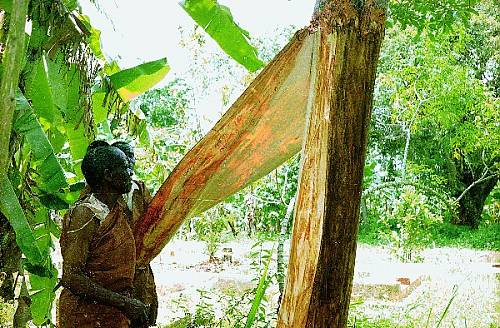Barkcloth making in Uganda
Inscribed in 2008 (3.COM) on the Representative List of the Intangible Cultural Heritage of Humanity (originally proclaimed in 2005)
Barkcloth making is an ancient craft of the Baganda people who live in the Buganda kingdom in southern Uganda. Traditionally, craftsmen of the Ngonge clan, headed by a kaboggoza, the hereditary chief craftsman have been manufacturing bark cloth for the Baganda royal family and the rest of the community. Its preparation involves one of humankind’s oldest savoir-faire, a prehistoric technique that predates the invention of weaving.
The inner bark of the Mutuba tree (Ficus natalensis) is harvested during the wet season and then, in a long and strenuous process, beaten with different types of wooden mallets to give it a soft and fine texture and an even terracotta colour. Craftsmen work in an open shed to protect the bark from drying out too quickly. Barkcloth is worn like a toga by both sexes, but women place a sash around the waist. While common barkcloth is terracotta in colour, barkcloth of kings and chiefs is dyed white or black and worn in a different style to underline their status. The cloth is mainly worn at coronation and healing ceremonies, funerals and cultural gatherings but is also used for curtains, mosquito screens, bedding and storage.
The production of barkcloth, which was widely spread with workshops in almost every village in the Buganda kingdom. With the introduction of cotton cloth by Arab caravan traders in the nineteenth century, production slowed and eventually faded out, limiting the use of barkcloth to cultural and spiritual functions. Nevertheless, barkcloth is still recognized among the Baganda community as a marker of specific social and cultural traditions. In recent years, the production of barkcloth has been greatly encouraged and promoted in the Buganda kingdom.



